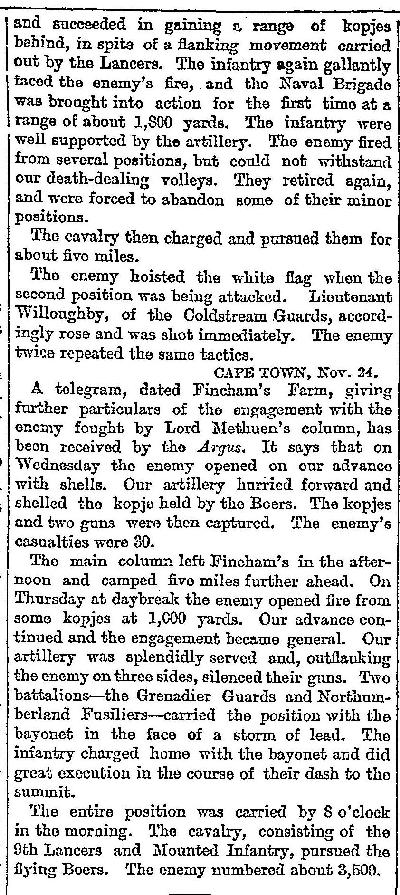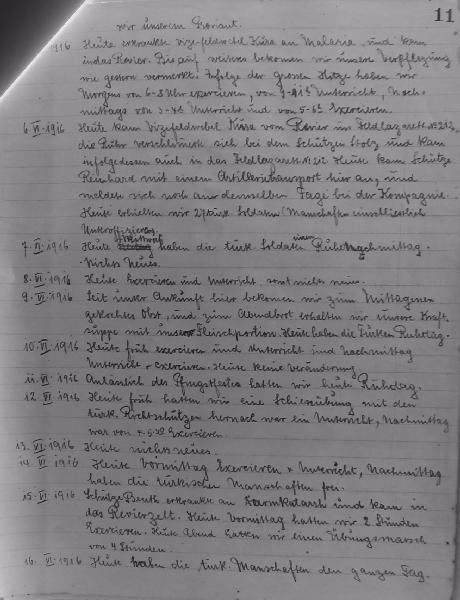Topic: BatzB - Belmont
Belmont
South Africa, 23 November 1899
Times, 25 November 1899, Account

LATEST INTELLIGENCE.
THE VICTORY AT BELMONT. GUARDS' BAYONET CHARGE
GERMAN COMMANDANT CAPTURED.
(FROM OUR SPECIAL CORRESPONDENT.)
BELMONT, Nov. 23.
After an artillery duel yesterday, a battle was fought at Belmont this morning. It opened at 3.56. The general idea was as follows:
The Guards' Brigade attacked the first position after a five-mile night march. It would be difficult to praise too highly the way in which they climbed the kopjes under an extremely heavy fire, which was reserved till they were within 250 yards. The Guards did not fire in reply, but used the bayonet only. It was one of the finest achievements of the Brigade.
After Clearing the position at 410 the Grenadier Guards, Scots Guards, and and Coldstream Guards covered the advance, clearing consecutively the' second and third positions. They suffered some casualties while approaching the second position. The 9th Brigade, supported by the Yorkshire Light Infantry and the Northumberland Fusiliers, was especially exposed to the concentrated Boer fire. The Naval Brigade with four guns was engaged in demolishing a lunette opposite our left centre and protecting their rear. Our artillery severely damaged the Boer laager in the rear.
After the battle the laager was burnt and the ammunition destroyed. The cavalry and mounted infantry on both flanks pursued the enemy, but were unable to overtake the retreating Boers, who got away with their transport. A considerable quantity of stores was captured, and a large number of horses.
Our losses were 226 killed and wounded, including Lieutenant and Adjutant Fryer. Lieutenant willoughby was treacherously shot at by an ambush which raised the white flag. Lieutenant Blundell was shot by a wounded Boer whom he was tending.
Especial gallantry was displayed by Major Milton, King's Own Yorkshire Light Infantry. At the close of the action the mounted infantry which he was leading fell into an ambush, and, whilst his men were making good their escape, he supplied a trooper whose horse had been killed with his own, and then walked away under heavy fire. Chaplain Hills also showed absolute carelessness of personal danger.
The Boer rout was complete. Their losses are estimated to be equal to ours, and 50 prisoners ware taken.
Our wounded include General Fetherstonhaugh, Colonel Crabbe, Major Dalrymple Hamilton, and Lieutenant Blundell.
Everything was in favour of the Boers to-day. It is rumoured that there have been threats of assassination of recalcitrant burghers who are growing tired of the war and deserting.
The prisoners say that before the fight the Boers thought that not all the European armies could drive them out from their position.
After the battle Lord Methuen made the following address to the troops :
"Comrades, I congratulate you on the complete success achieved by you this morning. The ground over which we have to fight presents exceptional difficulties, and we had as an enemy a past master in the tactics of mounted infantry. With troops such as you are, a commander can have no fear as to the result.
"There is a sad side, and you and I are thinking as much of those who have died for the honour of their country and of those who are suffering as we are thinking of our victory."
The Boers used some Dum Dum bullets.
The following telegram from the General Commanding Lines of Communication, dated Cape Town, Nov. 24, has been received at the War Office:
Methuen further reports this morning that wounded are going on well.
Over fifty prisoners, including German commandant and six field cornets-19 of these prisoners wounded. Unable to estimate Boer losses.
Prisoners say yesterday's attack was a surprise and the only beating they have had. A large amount of correspondence secured.
Reservists have done well.
Colonel Pole-Carew replaces Fetherstonhaugh in the command of 9th Brigade.
A second telegram says :
General First Division reports from Belmont Lieutenant W. A. Blundell, 3rd Grenadier Guards, died last night.
(FROM our correspondent.)
ORANGE RIVER, Nov. 23, Noon, via CAPE TOWN, Nov. 23.
Artillery firing began at 4.45 a.m. in the hills bearing east-north-east from Orange River, at an estimated distance of 12 miles. It ceased at 7 a.m. The enemy appeared to be retiring to the hills on the skyline bearing east-north-east, at an estimated distance of 15 miles from Orange River. The artillery is firing again now.
(THROUGH REUTER'S AGENCY.)
BELMONT, Nov. 24, 9.55 am.
The entire western division moved out from Orange River on Tuesday and bivouacked at Witteputs.
Two companies of Mounted Infantry and a detachment of the New South Wales Lancers were sent to hold Thomas's Farm. Pickets prevented the enemy from advancing. The Boers fired a cannon, but our artillery came up and silenced the enemy's fire.
At 2 o'clock on Thursday morning the Guards Brigade moved steadily forward to a kopje a few miles east of Belmont Station. The Scots Guards and Grenadier Guards advanced to within 50 yards of the enemy's base. The Boers sent in a scathing fire staggering the Guards momentarily, but the next instant they poured a deadly fire into the enemy.
At daybreak a rifle duel bean, and after it had been maintained for half an hour the artillery commenced practice. The Boers then relinquished their front position, and the Scots Guards rushed the kopje, carrying it at the point of the bayonet with a grand British cheer.
The 9th Brigade next moved forward in extended order, and the enemy started a terrible cross-fire from the surrounding kopjes.
The Coldstream Guards, supported by the Scots Guards, the Grenadier Guards, the Northumberland Fusiliers, and the Northampton Regiment; stormed the second position in the face of the enemy's fire, which was constant and effective.
The 9th Brigade advanced, covered by the artillery, which maintained excellent practice The infantry never wavered, and raised a tre
mendous cheer as they charred. The Boers fled

and succeeded in gaining r range of kopjes I behind, in spite of a flanking movement carried out by the Lancers. The infantry again gallantly faced the enemy's fire, and the Naval Brigade was brought into action for the first time at a range of about 1,800 yards. The infantry were well supported by the artillery. The enemy fired from several positions, but could not withstand our death-dealing volleys. They retired again, and were forced to abandon some of their minor positions.
The cavalry then charged and pursued them for about five miles.
The enemy hoisted the white flag when the second position was being attacked. Lieutenant Willoughby, of the Coldstream Guards, accordingly rose and was shot immediately. The enemy twice repeated the same tactics.
CAPE TOWN, Nov. 24.
A telegram, dated Fincham's Farm, giving further particulars of the engagement with the enemy fought by Lord Methuen's column, has been received by the Argus. It says that on Wednesday the enemy opened on our advance with shells. Our artillery hurried forward and shelled the kopje held by the Boers. The kopjes and two guns were hen captured. The enemy's casualties were 30.
The main column left Fincham's in the afternoon and camped five miles further ahead. On Thursday at daybreak the enemy opened fire from some kopjes at 1,000 yards. Our advance continued and the engagement became general. Our artillery was splendidly served and, outflanking the enemy on three sides, silenced their guns. Two battalions-the Grenadier Guards and Northumberland Fusiliers-carried the position with the bayonet in the face of a storm of lead. The infantry charged home with the bayonet and did great execution in the course of their dash to the summit.
The entire position was carried by 8 o'clock in the morning. The cavalry, consisting of the 9th Lancers and Mounted Infantry, pursued the flying Boers. The enemy numbered about 3,500.
Further Reading:
Battles where Australians fought, 1899-1920
Citation: Times, 25 November 1899, Account






